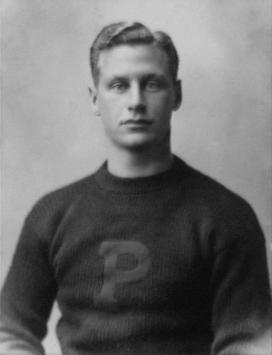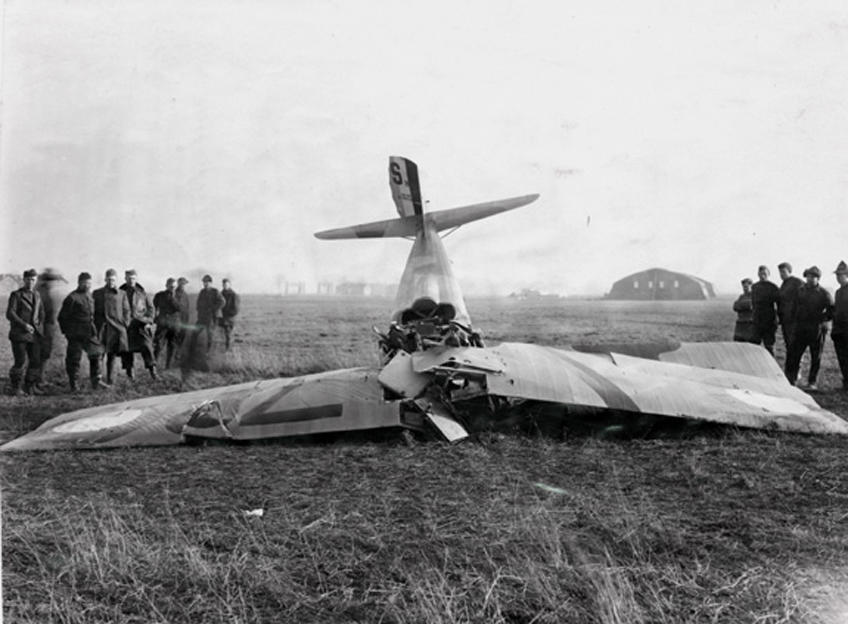Hobey Baker ’14: A Hero

Greatest of Princeton’s athletic heroes, Hobart Amory Hare Baker '14 is also her most reverenced war hero. A volunteer in the RAF, he was credited with seven planes before he transferred in April, 1918, to the 103rd Aero Squadron (formerly the daring Lafayette Escadrille) and within three months was appointed Commander. In October he was sent to the St. Mihiel Front with the 4th Pursuit Group stationed at Toul where he continued to fly and fight courageously, keenly, and fairly. He remained there until the end of the war. On the 21st of December, 1918, Hobey was preparing to catch the 9:00 o'clock train for Paris, but he wanted to take one "last flight in the old Spad" and just before dinner drove out to the Toul airdrome where he found mechanics warming up a newly repaired plane. Hobey, for some reason, insisted on taking this machine up instead of his own plane, and against the pleadings of both mechanics and fellow officers taxied down the field. He rose slowly, until about 150 feet off the ground, when the motor sputtered and died as he began to coast earthwards. There was a small grove of trees in which he could have set down without too much danger; but wishing to save the plane, he characteristically tried to circle back to the field. The machine lost airspeed, whirled out of control and crashed horribly.
He was dragged out of the wreckage but died almost immediately from internal injuries, thus ending the life of one of the finest gentlemen ever to graduate from this University. Even at St. Paul's, Hobey was determined to go to Princeton. His father, Alfred T. Baker '85 , had been a famous halfback and the family tradition was strong. Also the alumni were eager to acquire him for he was recognized as one of the best schoolboy hockey players in the country.
In his freshman year at Princeton he captained the football team, played on the basketball team, and proved himself an excellent swimmer, tennis player, marksman, and golfer. He was a natural athlete. There were no sports in which he did not excel. He had a perfect balance of mental and physical powers and held an extraordinary control over his body, being able to move any specified muscle at will. He was only 5 feet 10 inches tall, weighing approximately 160 pounds, but he had a more consistent record, and a greater following of alumni in hockey and football, especially the former, than anyone before or since. And no one ever did more for these games than he, by his sportsmanship and pure joy in playing.
The Bakers moved to Princeton while Hobey was still fairly young, purchasing "Castle Howard, " an historic homestead on the outskirts of the town. But as a student, Hobey lived at 82 Nassau St., over the Balt, where he received his few intimate friends and hordes of cloying adorers.
He was determined to live Princeton life to the fullest and performed everything with characteristic vigor and intensity, earning steady second groups, captaining football and hockey, debating with some eloquence, serving on both Junior and Senior Prom Committees, and on the Athletic Undergraduate Councils.
Among his other accomplishments was a bet to walk to New York in 10 hours, which feat enabled him to win enough money to carry him through four years of weekends.
He was responsible more than anyone else for making hockey a major sport in Princeton. Since there was no indoor rink, the team could practice only sporadically when the Lake was frozen or when enough players could find time to go up to the St. Nicholas rink in Brooklyn. Nevertheless the 1911-12 team, Hobey’s first, won the Intercollegiates, as Baker became renowned as the country’ greatest scoring machine.
There are many reports which attest to Hobey’s greatness as a hockey player. It is claimed that he never looked at the puck while skating, seeming to know where it was by the pressure of the stick on his wrist. The label "the fastest thing on ice " was never challenged, even by Canadian pros, his perfect coordination and instinct being miraculous and his courage never failing.
For three years he played varsity hockey and football, the two- sport rule preventing him from participating in the baseball games; then after graduation in 1914, he and his roommate, to whom much of this information is due, conceived a desire to make the "Grand Tour"; and loaded with two motorcycles " personally endorsed" by Hobey, they sailed for England. Much of the trip was financed by articles on English sports sent to the New York Times, written by both boys but signed by Hobey.
On his return, Hobey went to work for J. P. Morgan in New York, but late in 1916 he decided to chuck it all and enter the air service. He received preliminary training at Governor's Island, then at Mineola, N.Y., and on July 23, 1917, sailed for England.
From there he followed a gallant road to death, winning the Croix de Guerre and the U.S. Army citation "for distinguished services and exceptional gallantry. "
This was originally published in the January 18, 1957 issue of PAW.












No responses yet